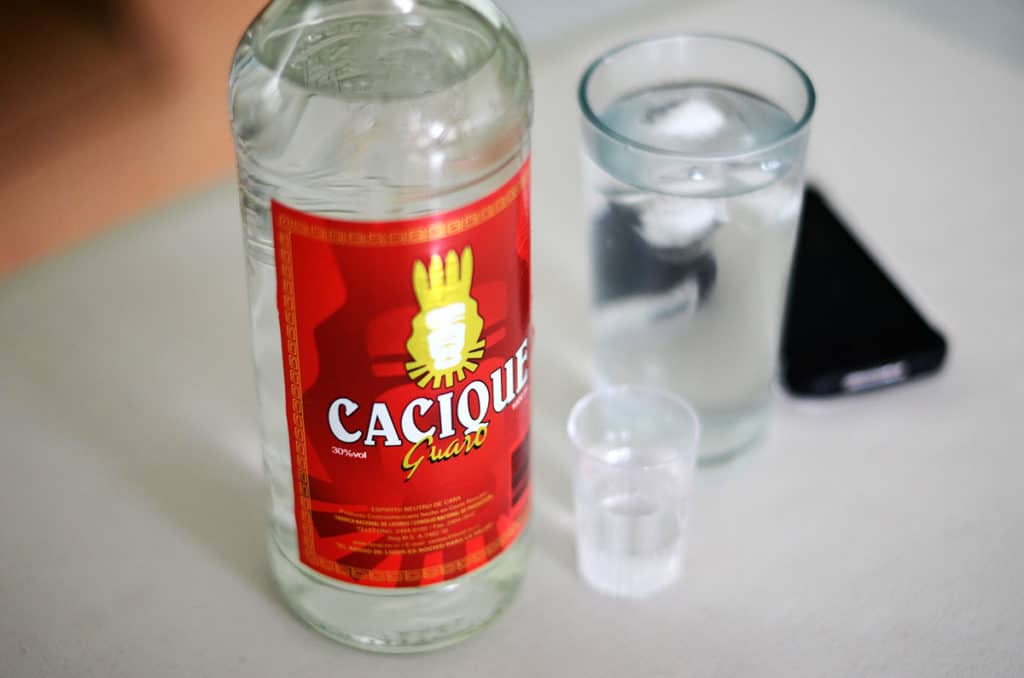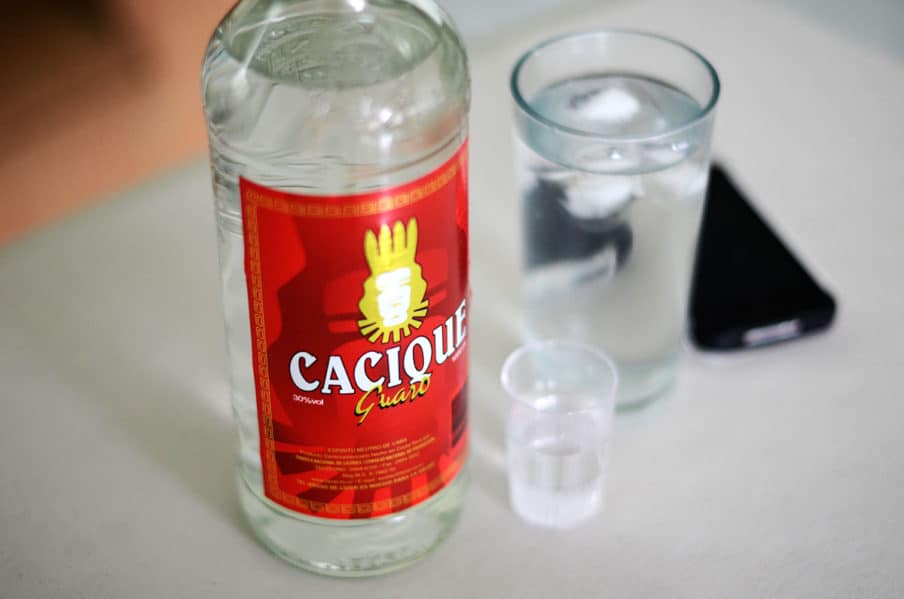
Cacique Guaro, Costa Rica’s beloved national liquor, is a clear spirit distilled from sugarcane juice, offering a subtly sweet flavor that sets it apart from other clear liquors like vodka or tequila. Known simply as “Guaro” to locals, this iconic drink is more than just a beverage—it’s a cornerstone of Costa Rican culture, woven into the fabric of social gatherings, celebrations, and even the nation’s economy. In this guide, we’ll explore the history, production, varieties, and cultural significance of Cacique Guaro, along with the best ways to enjoy it, whether you’re sipping it in a San José bar or mixing cocktails at home.
A Brief History of Guaro in Costa Rica
Guaro’s story begins in the colonial era, when sugarcane became a cash crop across Central America and the Caribbean. As sugar plantations flourished in Costa Rica’s fertile volcanic soil, locals discovered they could ferment and distill excess sugarcane juice into a potent spirit. Each region developed its own version of sugarcane liquor—rum in the Caribbean, aguardiente in Colombia, and Guaro in Costa Rica.
In its early days, Guaro was a homemade concoction, often dubbed “rural kitchen sink alcohol” or Costa Rica’s answer to moonshine. Produced in backyard stills, it was cheap, widely available, and wildly inconsistent. This lack of standardization posed serious risks, as improper distillation led to methanol poisoning, causing blindness or even death.
In 1851, the Costa Rican government intervened to curb these dangers. President Juan Rafael Mora Porras signed a resolution to nationalize Guaro production, banning clandestine distilleries and centralizing operations under state control. By 1853, the Fábrica Nacional de Licores (FANAL), or National Liquor Factory, was established in Grecia, ensuring safe, regulated production. This move not only improved public safety but also funneled revenue into the national treasury, bolstering Costa Rica’s economy alongside exports like coffee and bananas. FANAL maintains a monopoly on Guaro production to this day, making Cacique the only legally produced brand in the country.
The name “Cacique” emerged in 1980, inspired by a significant archaeological discovery near FANAL’s Grecia facility. Between 1977 and 1980, excavations uncovered one of Costa Rica’s largest indigenous settlements, dating back centuries. To honor this find, FANAL rebranded its Guaro as Cacique, meaning “leader of the tribe” in indigenous languages. The label, adorned with a native chief wearing a four-feathered headdress, earned the nickname “Cuatro Plumas” (Four Feathers) among locals—a playful nod to the iconic logo.
How Cacique Guaro Is Made
Crafting Cacique Guaro is a meticulous process that begins in the sugarcane fields of Guanacaste, a northwestern province known for its ideal growing conditions. Here, sugarcane is harvested and processed into a fermented liquid called “wash” or pre-processed alcohol. This raw material is transported to FANAL’s distillery in Grecia, where it undergoes distillation in column stills, reaching up to 96% alcohol by volume. The spirit is then diluted with water to achieve the desired strength, typically between 30% and 35% alcohol (60 to 70 proof), and filtered through activated carbon to enhance purity and smoothness.
After distillation, the Guaro is stored briefly—unlike rum, it requires no aging—and then bottled in FANAL’s automated facility. Machines fill, cap, and label each bottle, which is packaged in 365 ml plastic “pachitas,” 750 ml glass bottles, or 1-liter containers. The final product is shipped to warehouses and distributed to bars, restaurants, and stores across Costa Rica, where it’s a staple in every corner of the country.
Varieties of Cacique Guaro
Cacique Guaro comes in three distinct variants, each with a unique distillation process and flavor profile, distinguished by their label colors. The following table summarizes the differences:
| Variant | Label Color | Alcohol Content | Bottle Sizes | Notes |
|---|---|---|---|---|
| Guaro Cacique | Red | 30% (60 proof) | 365 ml, 750 ml, 1L | The classic, widely available version, often called “Pacha.” |
| Cacique Superior | Black | 35% (70 proof) | 365 ml, 750 ml | Higher purity, filtered through activated carbon for a smoother taste. |
| Roncolorado | Yellow | 30% (60 proof) | 365 ml, 1L | Less common, with a slightly different flavor profile. |
The red-label Guaro Cacique is the most popular, known for its affordability and versatility. Cacique Superior, with its black label, appeals to those seeking a cleaner, more refined spirit, while the yellow-label Roncolorado offers a unique twist, though it’s less prevalent in the market.
Why Cacique Guaro Is So Popular
Cacique Guaro’s enduring popularity stems from its deep cultural roots and accessibility. For Costa Ricans, it’s more than a drink—it’s a symbol of national pride, often mentioned alongside coffee, soccer, and the “Pura Vida” lifestyle. Its affordability, with shots costing as little as $1 during happy hour in some bars, makes it a go-to choice for locals and tourists alike. The spirit’s neutral, slightly sweet flavor also makes it incredibly versatile, perfect for sipping neat or mixing into cocktails.
Despite its dominance, Cacique has faced challenges in recent years. Sales have reportedly declined from 1.6 million 12-liter boxes in 2000 to 450,000 annually by 2018, a 72% drop, partly due to competition from contraband liquors and changing consumer preferences.
Additionally, in 2021, at least 50 deaths in San José were linked to illegally produced Guaro containing high methanol levels, underscoring the importance of purchasing only FANAL-regulated Cacique from reputable sources like supermarkets, liquor stores, or established bars. For travelers, this serves as a reminder to avoid unregulated vendors and stick to trusted establishments.
How to Enjoy Cacique Guaro
Guaro’s versatility shines in how it’s consumed. For purists, a chilled straight shot is the traditional way, often served with a salt or sugar rim and a lime wedge to enhance the experience. The spirit’s smoothness makes it approachable, though its potency—especially in the 70-proof Superior variant—demands respect. In bars, you might hear locals jokingly warn about Guaro’s sneaky strength, as its mild flavor can mask its kick, leading to one too many shots.
Cocktails, however, are where Guaro truly excels. The most famous is the Chiliguaro, Costa Rica’s answer to a Bloody Mary. This fiery shot combines Guaro with tomato juice, lime, hot sauce, and a dash of Lizano sauce, a tangy Costa Rican condiment. Every bartender has their own recipe, making Chiliguaro a must-try at different venues to discover your favorite. Other popular cocktails include:
- Guaro Sour: A refreshing mix of Guaro, lime juice, simple syrup, and club soda, served over ice—perfect for a beachside sunset.
- Pura Vida: A tropical punch blending Guaro with pineapple juice, orange juice, triple sec, and a splash of grenadine, embodying Costa Rica’s vibrant spirit.
- Coco Loco: Served in a fresh coconut, this indulgent drink mixes Guaro with coconut milk, rum, and fruit juices, often enjoyed frozen.
- Miguelito: A beach-bar favorite, combining Guaro with coconut water and a touch of condensed milk for a creamy, tropical shot.
For those looking to recreate these at home, Cacique Guaro is available at Costa Rican supermarkets and duty-free shops, though it’s not widely sold outside the country. Be cautious when packing it for travel, as U.S. TSA regulations may flag large bottles in carry-ons, requiring checked luggage.
Cacique Guaro in Modern Costa Rica
In recent years, Guaro has seen a renaissance, with mixologists elevating it from a working-class staple to a craft cocktail star. Bars like Selvatica in San José and Pocket in Escazú showcase Guaro in innovative drinks, from jalapeño-infused Guaro Sours to passion fruit margaritas. This trend aligns with Costa Rica’s booming craft beer scene, positioning Guaro as a potential global spirit, much like tequila or mezcal. However, FANAL’s monopoly limits experimentation, as other distilleries must seek special concessions to produce their own versions.
Despite its cultural significance, Cacique Guaro isn’t without critics. Some compare it to “poor man’s vodka,” citing its neutral flavor, while others lament missed opportunities to market it as a premium brand, like Nicaragua’s Flor de Caña rum. Posts on X have echoed this sentiment, with users suggesting FANAL could elevate Cacique into a world-class spirit with better branding. Still, for most Costa Ricans, Guaro remains a source of pride, a cheap and cheerful way to toast to “Pura Vida.”
Tips for Enjoying Guaro as a Traveler

If you’re visiting Costa Rica, sampling Cacique Guaro is a must. Stick to reputable bars, restaurants, or hotels to ensure you’re getting authentic, safe Cacique. For a bottle to take home, shop at grocery stores like Auto Mercado or duty-free shops at the airport, but verify TSA rules for your destination. When ordering cocktails, don’t be afraid to ask bartenders about their Chiliguaro recipe—engaging with locals can lead to memorable experiences and insider tips.
For the adventurous, try Guaro at a beach bar in Playa Flamingo or a rooftop lounge in San José to soak in the full Costa Rican vibe. Just pace yourself—Guaro’s smooth taste can sneak up on you, and nobody wants a hangover to derail their tropical adventure.
Cacique Guaro is more than a drink; it’s a taste of Costa Rica’s history, resilience, and zest for life. Whether you’re downing a Chiliguaro shot or sipping a Guaro Sour by the beach, you’re partaking in a tradition that’s been bringing Ticos together forstill bringing Ticos together for over 170 years. So, grab a bottle, raise a glass, and say “Pura Vida” to Costa Rica’s national liquor.

